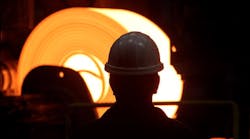Is it time to call the bottom of the steel market? Lakshmi Mittal seems to think so.
The billionaire CEO of ArcelorMittal, the world’s largest steelmaker, told the Financial Times this month that the trough had been reached and “things should continue to improve.”
Is he right? ArcelorMittal’s shares have gained more than 75% since early February — despite a $3 billion rights offering that will dilute existing shareholders.
The stock has tracked an upturn in steel spot prices in Europe, which in part reflect the continent’s new urgency in trying to tackle a flood of cheap steel imports from China. The EU last month imposed anti-dumping duties on some steel imports from China and Russia, and said it would open more probes into other products.
In China, production cuts have also helped local steel prices to climb. Steel exports surged 20% last year to a record 112.4 million tons; price increases could lessen the incentive to send that surplus steel overseas.
There are problems with this “glass is half full” thesis, though. China says it will cut up to 150 million tons of surplus steel production in coming years — about 13% of total capacity. But rising prices could encourage idled steel mills to re-start production, delaying that adjustment.
And quite how China will cut all that capacity without ultimately triggering losses for lenders also remains a mystery. Seth Rosenfeld, an analyst at Jefferies, says the country’s steel industry has about $520 billion of debt — mostly held by state-owned banks.
It’s also debatable whether China is seeing a sustainable — rather than purely seasonal — uptick in steel demand. Massive overbuilding in residential construction and overcapacity in a host of industries remain a burden on the economy. In February, China’s manufacturing purchasing managers index dropped to its weakest level since early 2009.
Global steel production declined 3.3% in February compared to the prior year total, according to the World Steel Association. The fall might provide limited support for prices, but hardly represents a vote of confidence in global demand conditions.
Capacity utilization in the global steel industry has improved a little, but remains a miserable 66.2%, almost 6 percentage points lower than a year ago. That’s well below the level of about 80% to 85% normally needed to sustain pricing power.
To be sure, the EU’s February decision will give some help to steelmakers. Moody’s, the rating company, says the levies will slow the growth of imports into Europe and allow domestic players to raise prices.
German steelmaker Salzgitter is likely to be a key beneficiary, because almost half of its shipments are made up of products subject to import tariffs or investigations, according to Rosenfeld at Jefferies. But those tariffs are a long way from being a panacea for Europe’s steel industry, particularly for a company like ArcelorMittal that operates across international markets.
Europe’s steel industry can’t pin all the blame on China for its present woes. As recently as 2013 (when China’s imports weren’t such a problem), industry overcapacity in Europe stood at 80 million tonnes, a third of total production for the region. Unless demand picks up — hardly a certainty considering the rather disappointing impact of near-zero interest rates on corporate investment behavior so far — Europe’s steelmakers may yet need to follow Tata Steel’s lead and shutter more production capacity of their own.
Until then, Mittal’s faith in the upswing seems premature.
By Chris Bryant



